A Bed Stuy Homeowner Makes a Plasterwork Palace Her Own
A Bed Stuy homeowner tackled the restoration of crumbling plaster detail and much-painted woodwork with gusto and patience, then gave her witty design sensibilities free rein.

A view of the parlor floor in Shelley Victory’s 1890s Bed Stuy row house displays its extraordinary attributes: elaborate plaster decoration on walls and ceiling, extensive original woodwork and furnishings that are anything but conventional. Photo by Lesley Unruh
Shelley Victory gestured into the front parlor of her limestone townhouse, whose walls and ceilings are covered with elaborate plaster relief decoration in varying states of repair, from nil to perfection. “Look at this plasterwork!” she exclaimed. “Isn’t it obnoxious?”
She doesn’t mean obnoxious in a pejorative sense, of course. It’s Victory’s synonym for fabulous, over-the-top, beyond belief. And indeed it is. Victory conjectures that her unusual house, one of a row on a leafy Bedford-Stuyvesant block designed by architect John E. Dwyer in the last decade of the 19th century, was “more than likely” decorated by the developer expressly to show off the plasterwork options available to buyers in the neighborhood’s then-booming new-home market. That may explain why motifs vary from florals and scrollwork to swags and even musical instruments throughout the parlor floor.
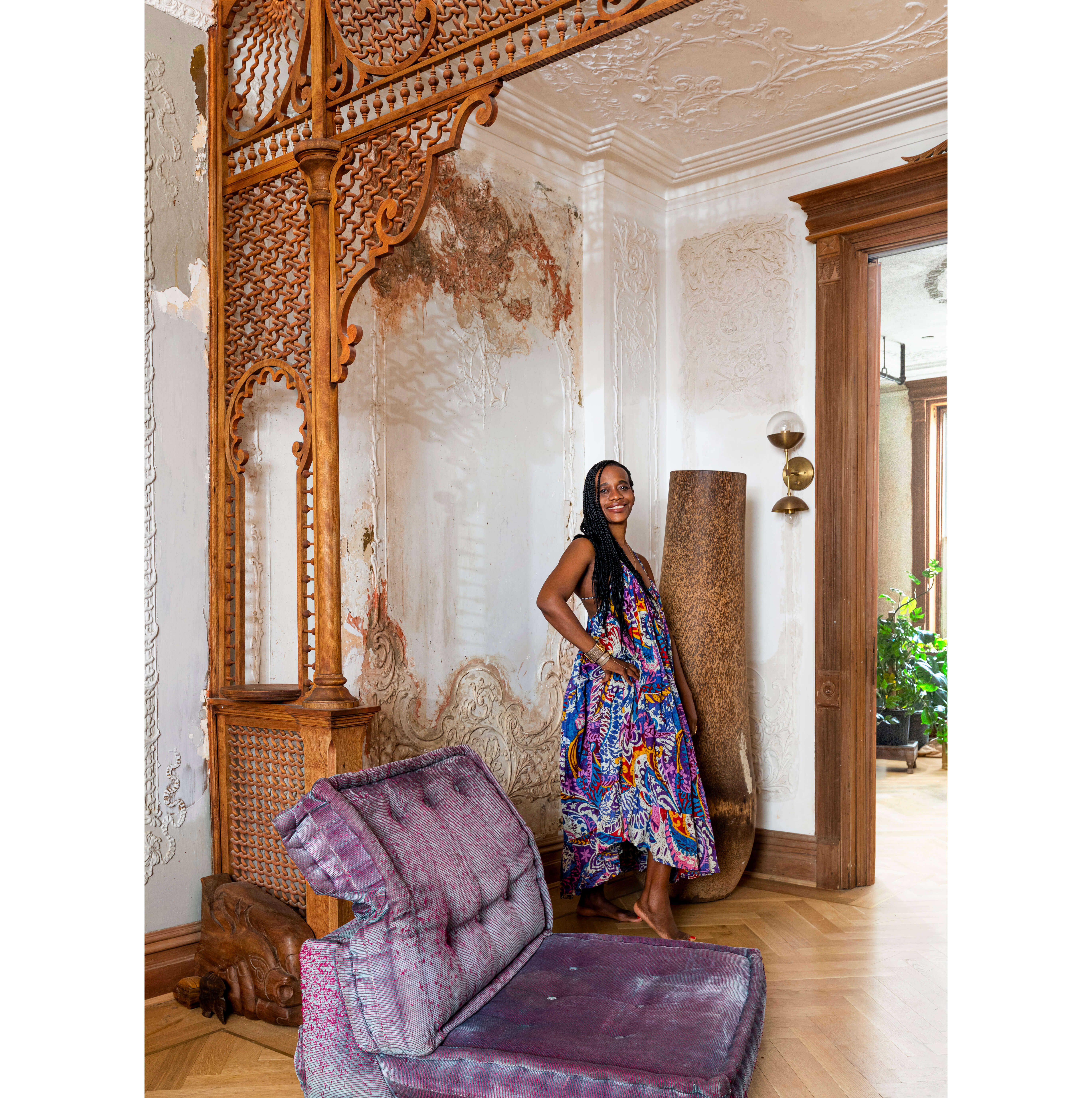
The house boasts an abundance of original woodwork as well, including exuberant fretwork spanning the parlor, five carved wood fireplace mantels, and intact door and window trim, albeit all “covered with a good eight layers of paint,” Victory said, when she bought the house in 2007.
Though the house served as a rooming house for decades, the overall layout survived largely intact and without partitions, and its detail remarkably so. Still, more than a century of wear and tear took its toll, and many prospective buyers were daunted by the degree of restoration required. But not Victory, a native New Yorker, raised in Queens, who had bought a condo in Bed Stuy five years earlier while continuing to covet the brownstones she saw on the neighborhood’s annual house tour.
Victory first spotted her plasterwork palace at a realtor’s open house, along with about 15 other people. “They saw all of this plasterwork and said, ‘Oh, this is disgusting,’” and talked about wanting to gut the house, she recalled. It was the very first house she’d seen once she started seriously looking. Victory made an offer, but the deal didn’t pan out, and she spent the next year looking at about 20 more houses. But they weren’t as wide, they weren’t four stories and they weren’t as decoratively fabulous. Eventually she circled back and found that the house was still available. This time, Victory closed the deal, installing herself on the two lower floors.
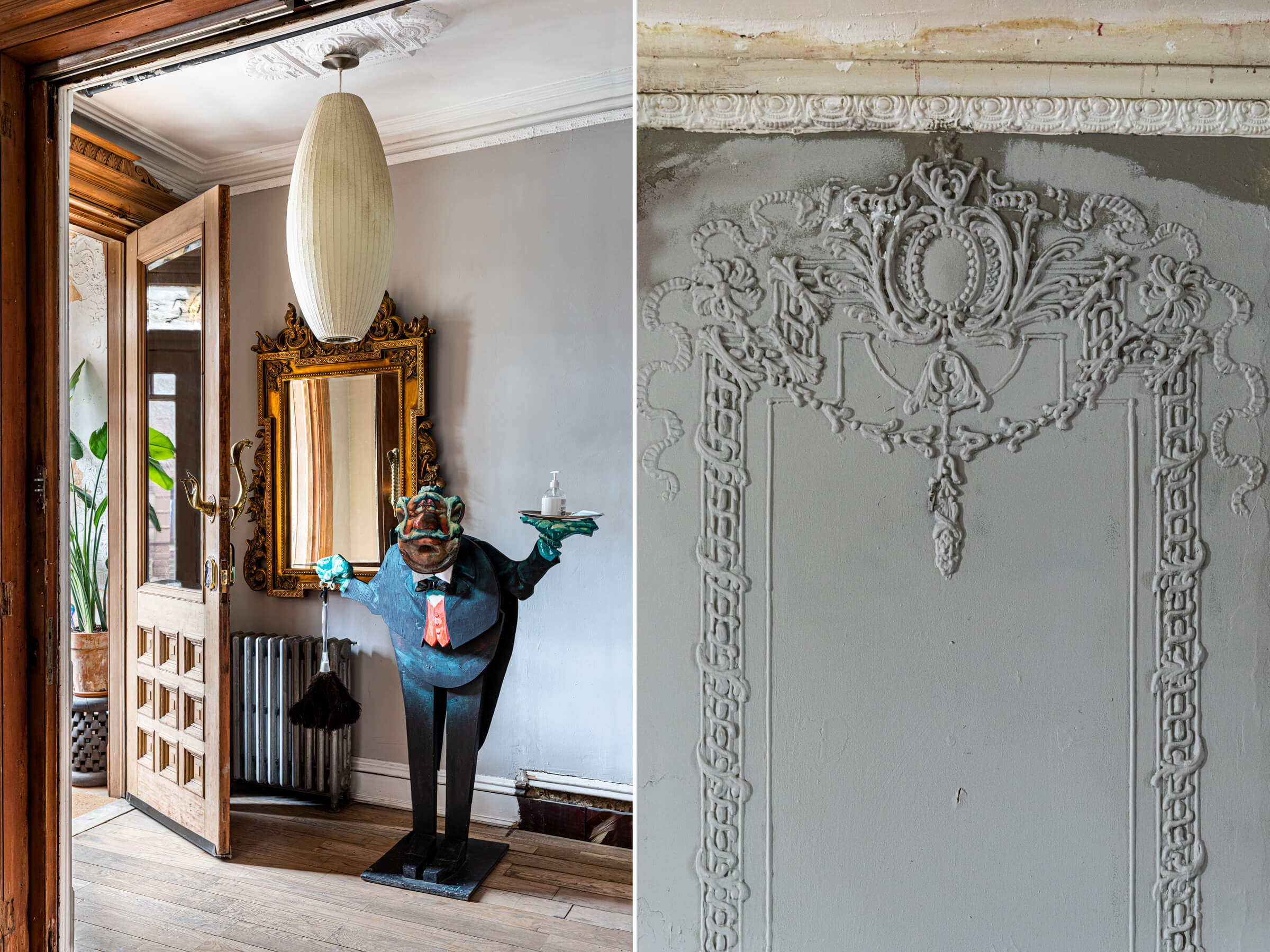
Then the fun began. Victory, a fashion designer and illustrator who began working for Ralph Lauren around that same time, waded in quite calmly. “When I first bought my condo, I went full on, did this, did that. When I got this house, I decided, ‘I’ll live in the space until it tells me what it needs to be,’” she said. Beginning with the garden-level front bedroom, whose outstanding feature is glorious wood wainscoting but which, like the other rooms, was “a hot mess” swathed in wall-to-wall carpeting, she gradually made the place livable, with the help of a few fortuitous recommendations.
“Someone told me about a woman named Betty James from the island of Saint Vincent, who strips wood. I said, ‘Can I work alongside you?’ She taught me how to do it with Zip Strip and a heat gun,’” Victory said, until all the woodwork, including some exceptionally finicky, twisty bits of fretwork, was returned to its natural essence, needing no additional stain or finish.
The plaster situation was even more of a challenge. “So much of the plaster was cracking, at times I wanted to scrape it all off and go with Sheetrock,” Victory said. A turning point came when her plumber mentioned that he knew “an amazing plaster guy.” Raul Agrippa of Brooklyn-based Agrippa Plasterers “camped out in this house for a year, while I lived with scaffolding and dust.” The work has continued in fits and starts for a decade and a half, pending available funds and craftspeople. “It’s not yet complete,” Victory said. “The living room ceiling and the entry are still to be done.”
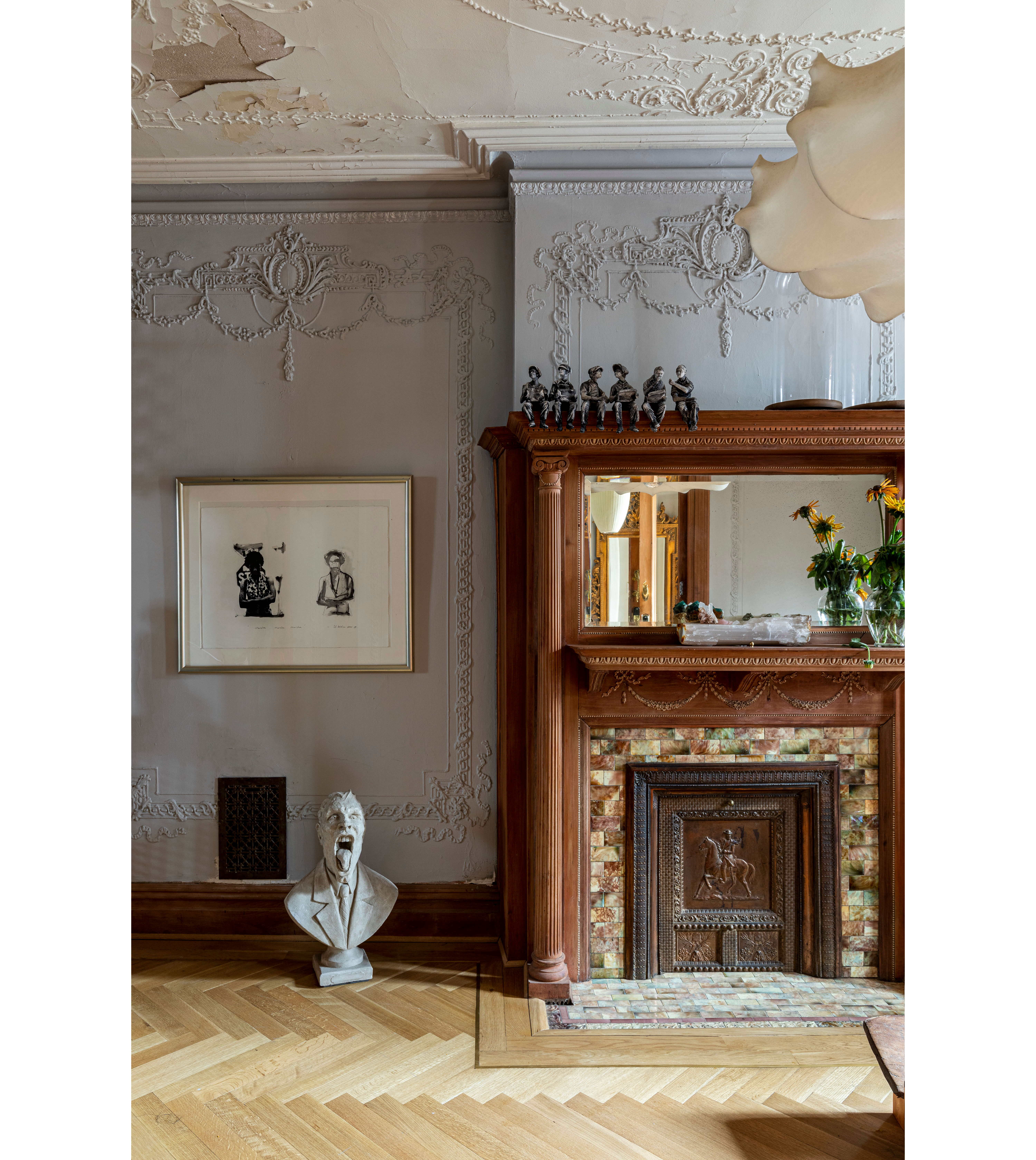
Agrippa’s methodology has been to first clean and document the original bas-relief detail. After creating new, smooth surfaces with modern materials, he re-creates the damaged ornament. There have been disasters along the way, to be sure. An electrician using a buzzing saw was “so aggressive with his machinery that the vibration shook half the kitchen ceiling, including the medallion, to the floor,” Victory said. “I gathered up the pieces and Raul put it all back together, like Humpty Dumpty.”
A couple of years ago, when Victory laid a new herringbone-pattern white oak floor throughout the parlor level, the existing Ikea kitchen at the rear “fell apart.” She had just started to remodel the old kitchen when COVID-19 hit, interrupting her plans.
Victory’s kitchen may be rudimentary at the moment, but it is a grandly proportioned, south-facing space, with an adjacent new half-bath in a closet formerly occupied by a dumbwaiter. It serves for cooking the dishes Victory loves from her parents’ native Trinidad, but mostly it’s a greenhouse for a collection of thriving houseplants. “I have embraced my green thumb,” she said. It’s but one of her many hobbies, which also include museum- and gallery-hopping, in normal times, as well as pole dancing. There’s a pole installed for the purpose in the middle of the parlor floor. “I recommend it for every woman,” Victory said.
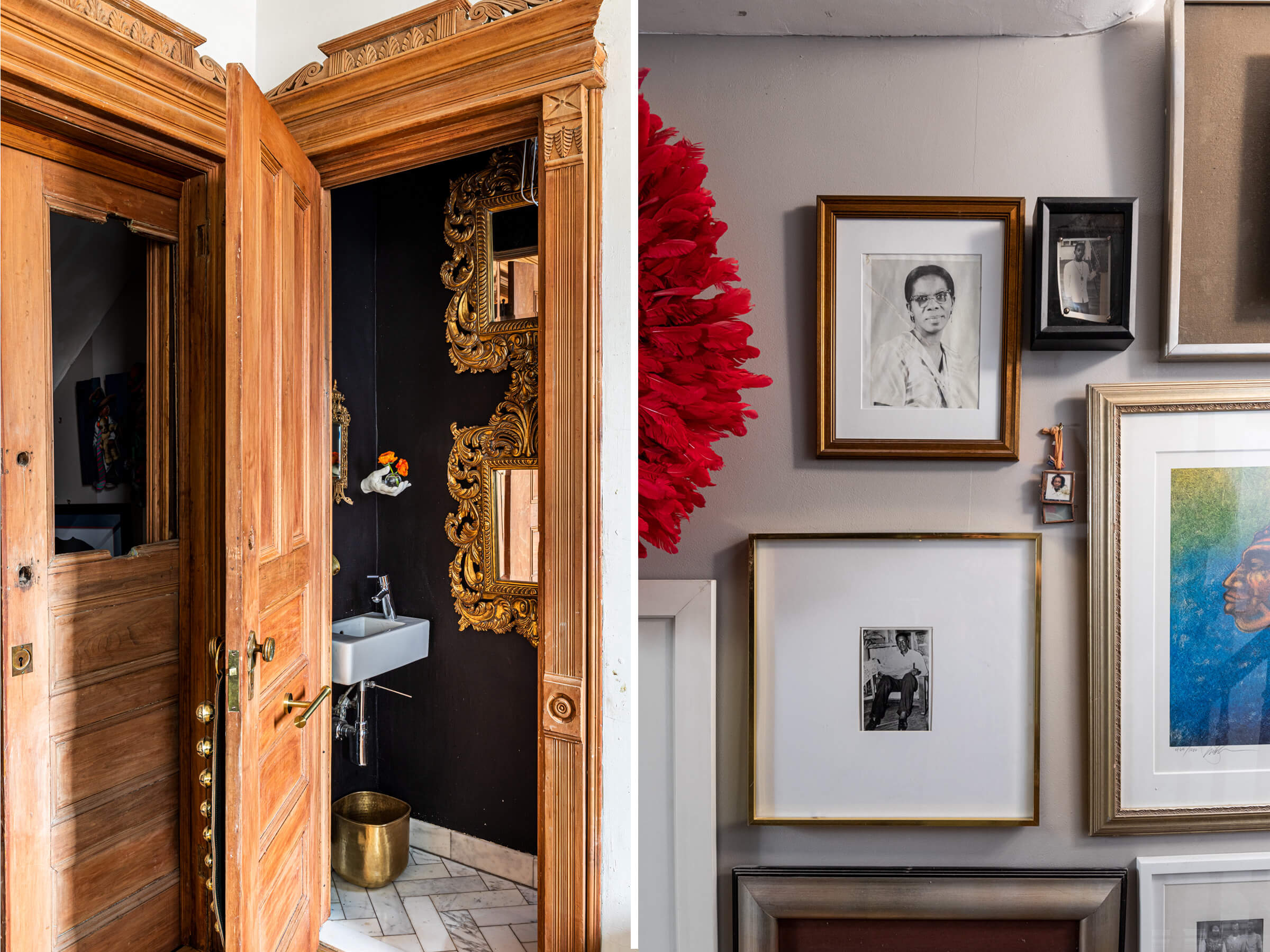
No less extraordinary than the house’s architectural attributes is Victory’s witty, no-holds-barred decor. By turns modern and romantic, anchored by often-whimsical contemporary artworks and handcrafted solid-wood objects from disparate locales, Victory’s interior design is an expression of her unique creative vision.
“I worked at Ralph for so long, I came to understand the idea of lifestyle — clothing and home as a personal brand – and of not letting my interior space be disassociated from who I am,” she said. She owns up to “drinking some of the Kool-Aid” while at Ralph Lauren, but that didn’t prove permanent. “For a while, I was all cream and sisal, but now I have a more bohemian approach, and I want color.”
Case in point: the five vari-colored sections of a Roche Bobois sofa from the Mah Jong collection, designed in the 1970s, that dominates the front parlor. “I’ve been cutting and pasting this sofa,” Victory said, finding its component velvet-covered sections piece by piece. She bought an orange section and, on sale, a brown section from the Roche Bobois store; the rest, in blue and lavender, came from Chairish and craigslist. The other showstopping piece in the front parlor is an otherworldly looking ‘Cocoon’ ceiling pendant by mid-century Italian lighting master Achille Castiglioni, found at a Design Within Reach outlet. “Isn’t it obnoxious?”
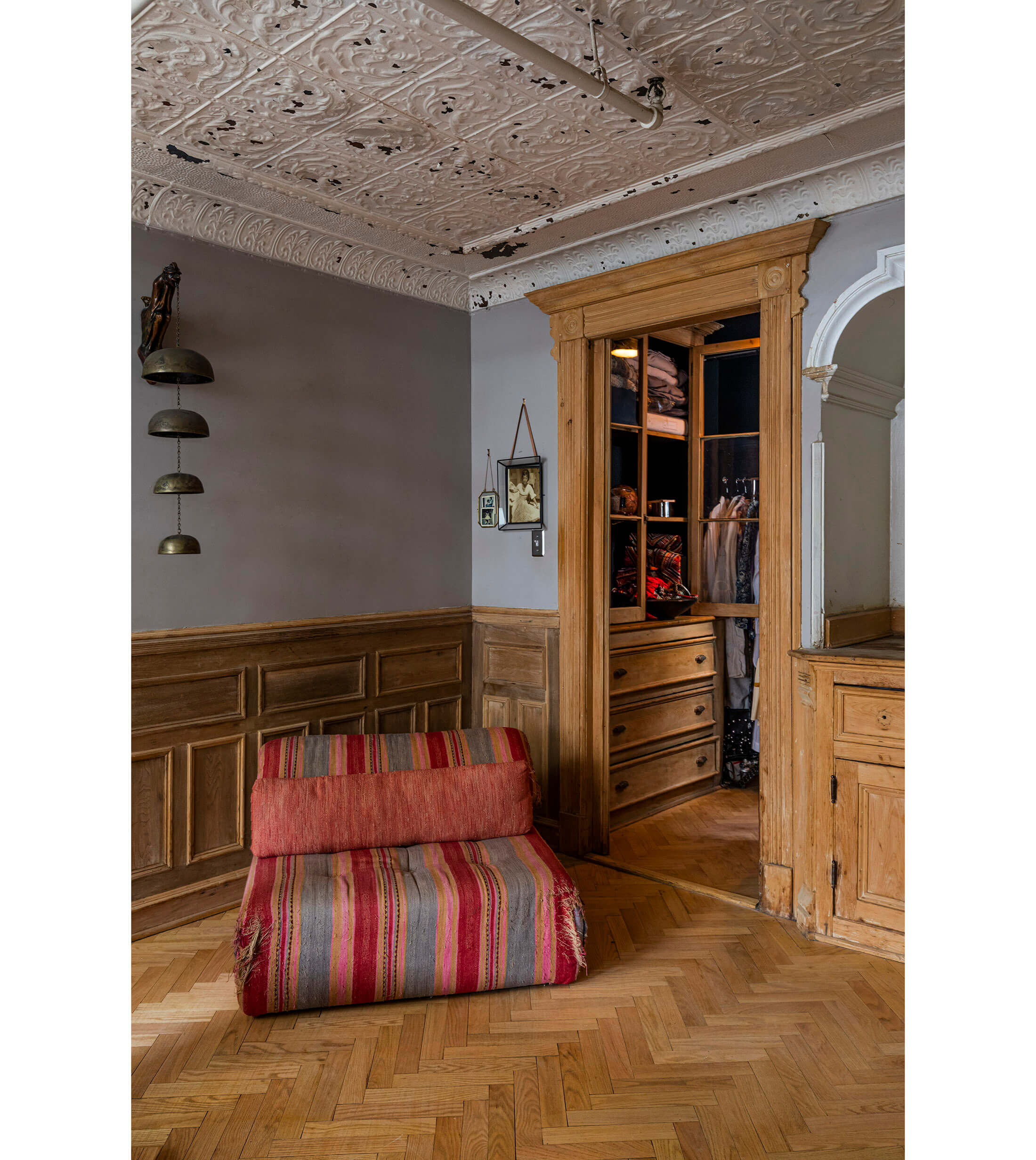
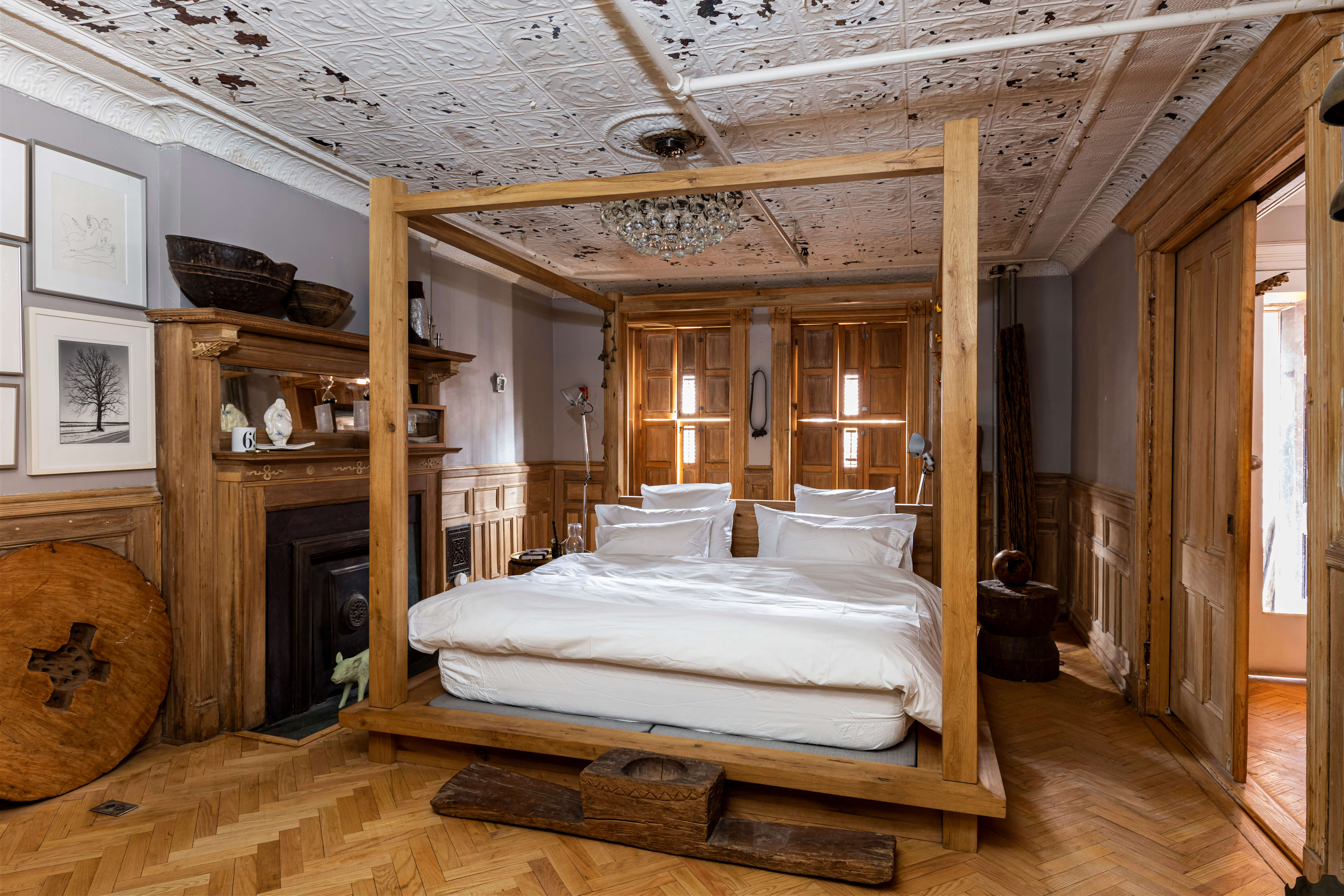
“I’m always looking for the best bargains,” said Victory, who also counts Housing Works and City Opera Thrift Shop in West Chelsea as favorite hunting grounds. Another is the Tucker Robbins showroom at 200 Lex, which specializes in pieces made using ancient craft techniques, like the carved wood pole from the West African Dogon culture that stands in a corner of the front parlor. “I’m drawn to pieces from a variety of cultures and objects so organic, they could be from anywhere.”
In normal times, Victory frequents art shows and galleries for such works as the oversized painting of “naughty dolls” by contemporary Singaporean-American artist Su-en Wong; “Ugly Bastard,” a ceramic bust by British-American sculptor Emil Alzamora; and the painted wood butler by African-American artist Robert Carter in the front hall, currently offering hand sanitizer.
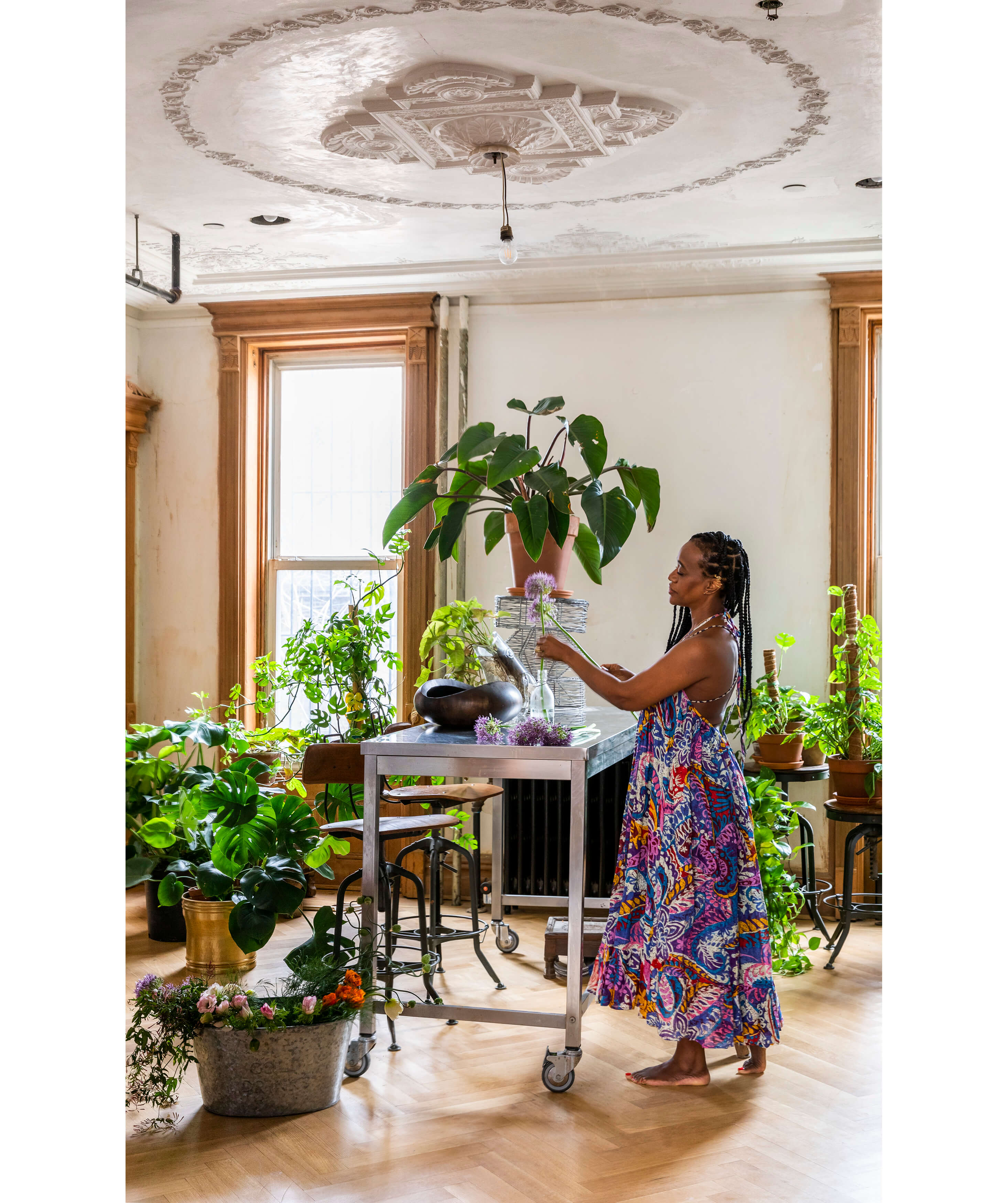
Victory, who studied fine arts at Howard University and fashion design at the Fashion Institute of Technology, has worked for a number of well-known design firms, including Kenneth Cole and Donna Karan’s Urban Zen. Since the pandemic hit, she’s been working as a freelance illustrator and, like many, staying close to home.
She can’t wait for things to open up. “I think that, after the pandemic, women are going to want to dress up. There will be a backlash from sweats and leggings and robes and only getting half-dressed,” she said. “We’re going to want to wear pretty clothes again. We’re going to want to be peacocks. I feel it in the air.”
[Photos by Lesley Unruh | Styling by Heather Greene]
Editor’s note: A version of this story appeared in the Spring/Summer 2021 issue of Brownstoner magazine.
Related Stories
- Bohemian Rhapsody: Layered With History, a Prospect Heights Brownstone Embraces Color
- Schoolteacher’s Coup: Seeking an Integrated Neighborhood, a Couple Restores an 1899 House
- Going Back Home: Artist Paul Sue-Pat Brings Life to a Bed Stuy Townhouse
Email tips@brownstoner.com with further comments, questions or tips. Follow Brownstoner on Twitter and Instagram, and like us on Facebook.

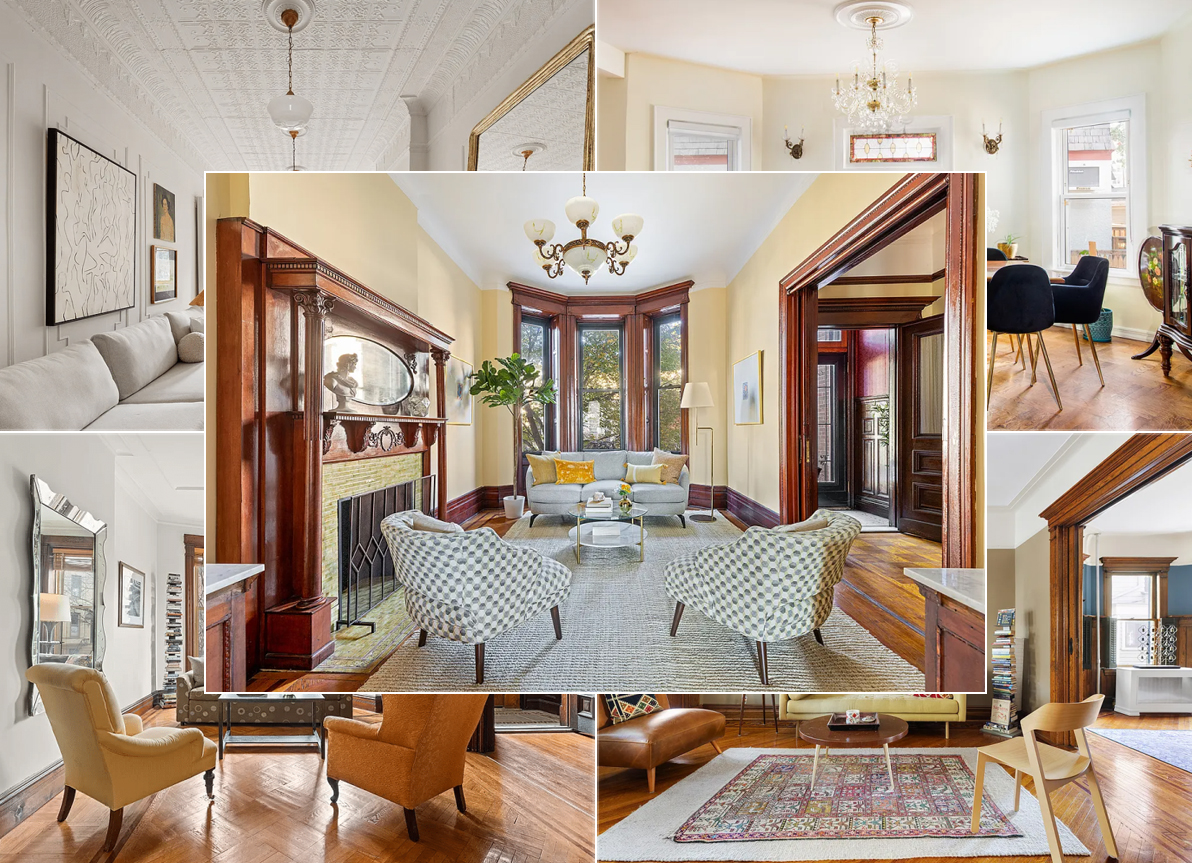
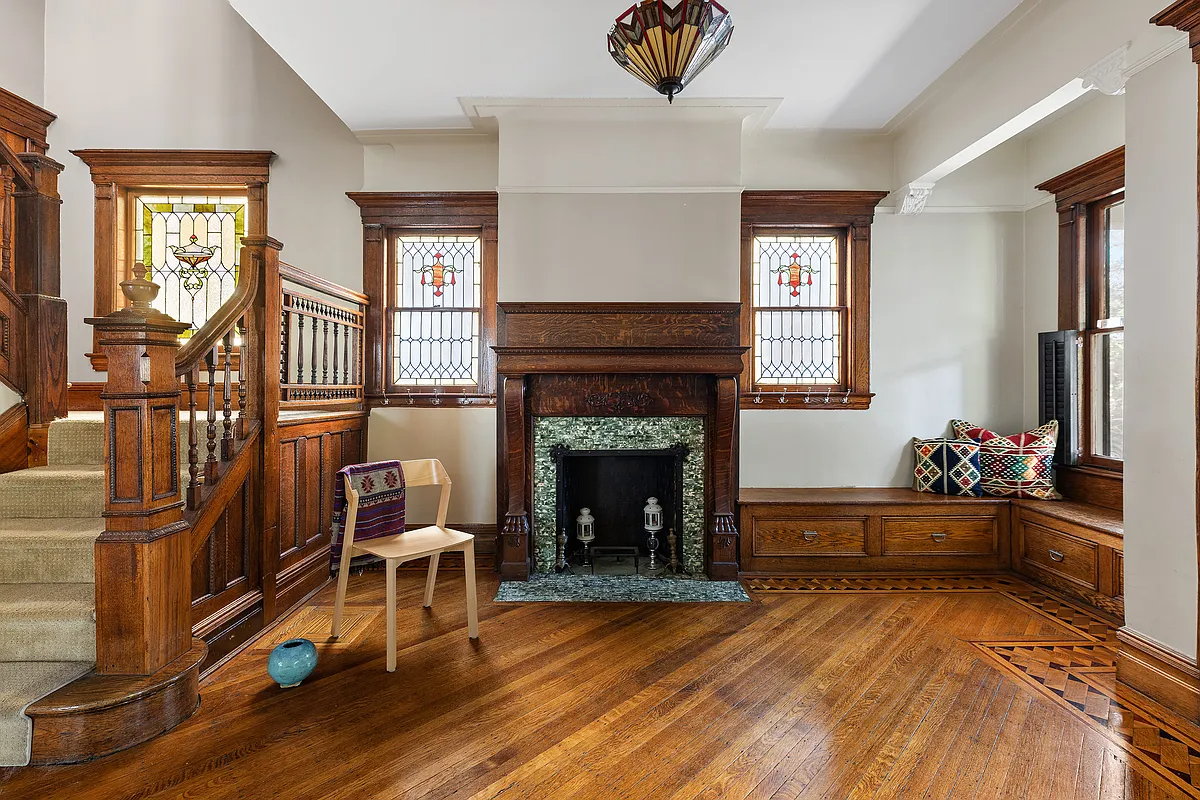
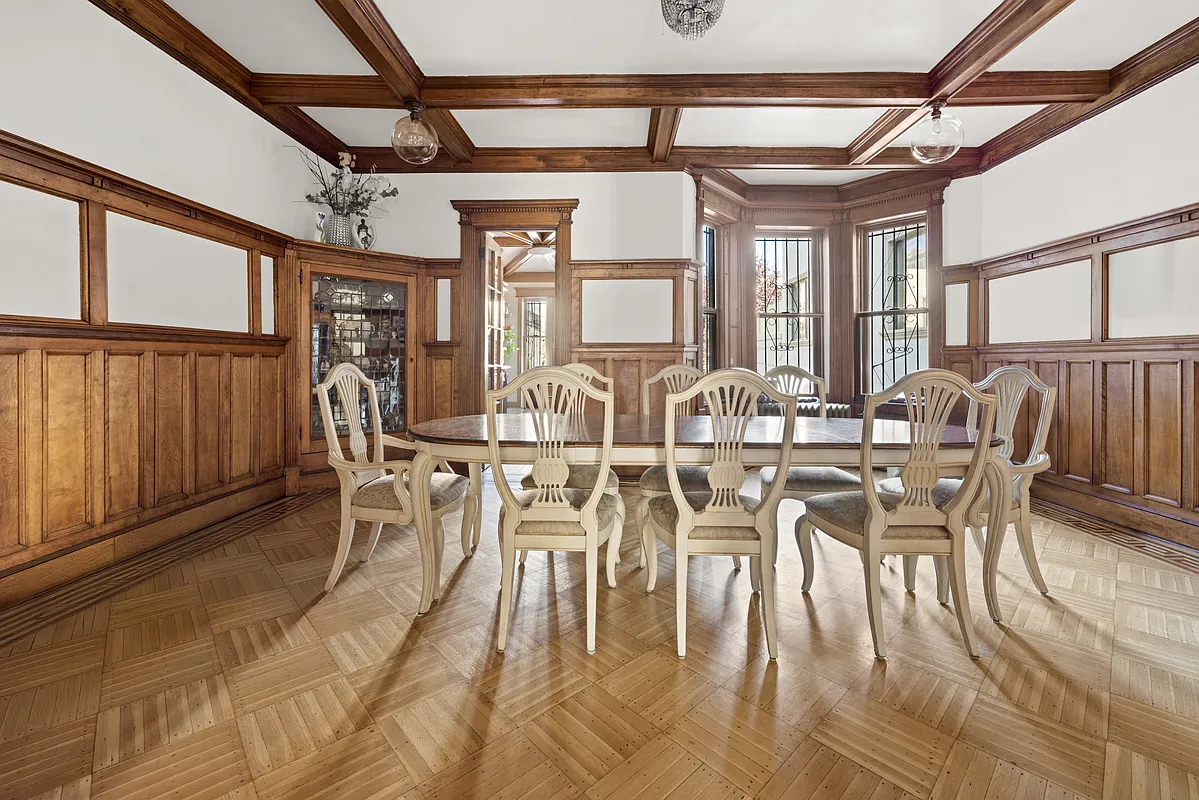
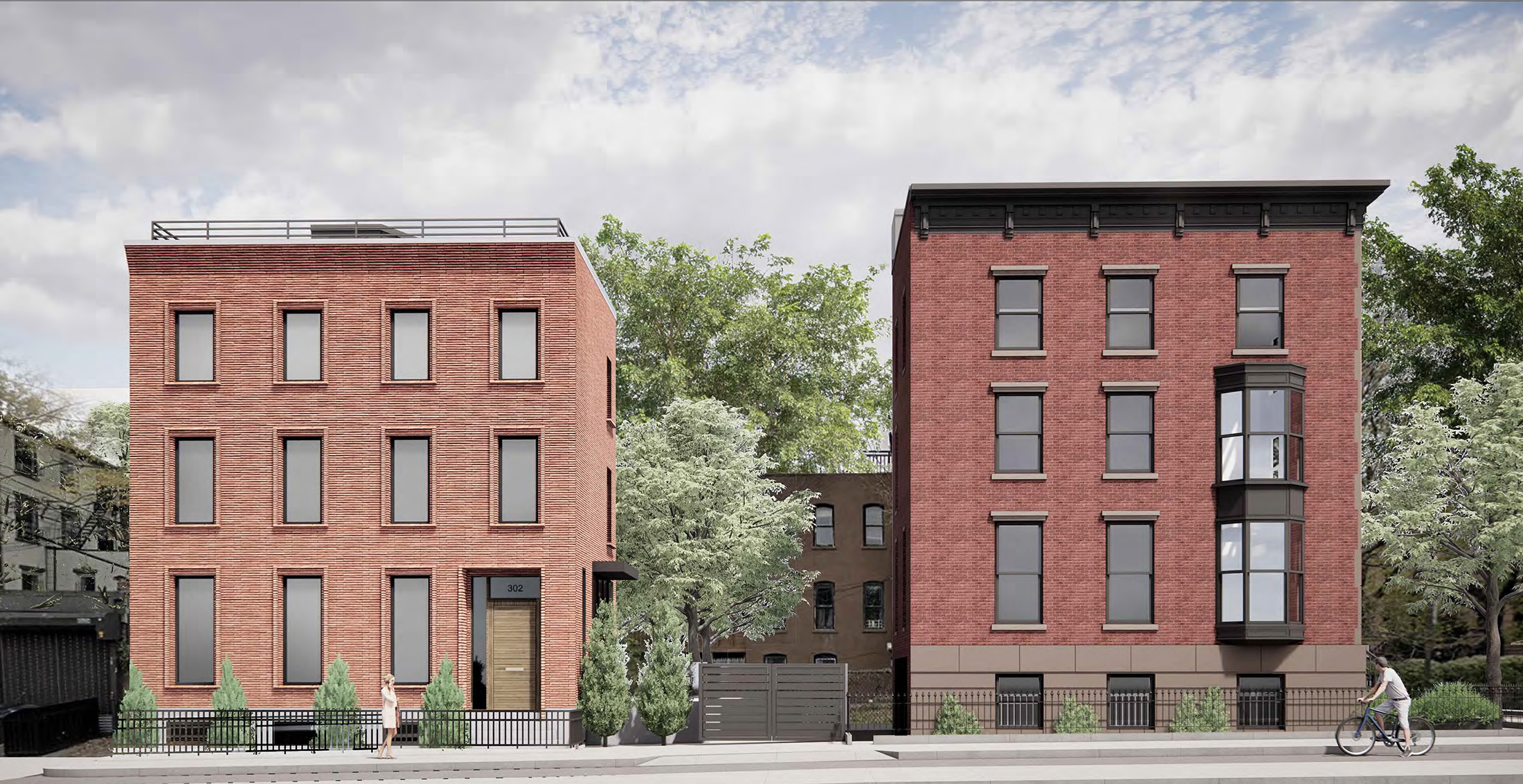
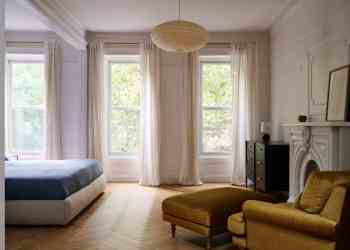



What's Your Take? Leave a Comment